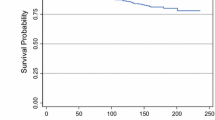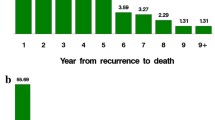Summary
This study of the natural history of human breast cancer was based on the analysis of a series of 3000 patients treated by radical mastectomy at a single institution (Institut Gustave Roussy) at a time when adjuvant chemotherapy was not prescribed. The follow-up of the patients ranged from 15 to 30 years; for each patient the tumor size, the number of involved axillary nodes, and the histological grade were prospectively registered.
A highly significant correlation was found between tumor size and the probability of distant metastatic dissemination. The distribution of tumor sizes at metastatic spread was log-normal with a median diameter equal to 3.5 cm.
The patients were subdivided into 3 groups according to the histological grade. In each subgroup there was a significant correlation between tumor size and the probability of distant spread; the distributions were log-normal and the median size was markedly larger for grade 1 tumors. Moreover the proportion of grade 1 tumors was higher in small tumors than in large ones while the reverse was observed for grade 3 tumors; these data suggest that during their growth tumors progress towards higher grades.
One of the chief fundamental characteristics of a tumor seems to be its propensity for axillary node invasion. The orderly pattern of nodal involvement makes it possible to calculate the tumor size at invasion of the first axillary node in each subset of patients. A strong and highly significant correlation exists between the size of the tumor at initation of distant metastasis and at invasion of the first lymph node. However the capacity for lymphatic spread is, on average, acquired much earlier than the capacity for metastatic spread.
With a simple model based on these data it was possible to compute the proportion of patients with occult metastases as a function of tumor size, histological grade, and number of involved axillary nodes.
Early invasion of axillary nodes is associated with a rapid growth rate of the primary tumor (or a high S-phase fraction). However each of these variables has an independent prognostic significance; the S-phase fraction appears as one of the strongest prognostic indicators.
A model of tumor growth was used to assess the impact of screening procedures on the proportion of patients with distant metastases. The predictions of the model are consistent with the results of the screening programs. The model was used to predict the influence of the interval between mammographies on the proportion of patients with distant metastases and on the size of these metastases. Since the curability of distant metastases by adjuvant chemotherapy is, to a large extent, governed by their size, the model can predict the cumulative effect of screening procedures and adjuvant chemotherapy on the proportion of patients with overt distant metastases.
Similar content being viewed by others
References
Early Breast Cancer Trialists' Collaboration Group: Effects of adjuvant tamoxifen and of cytotoxic therapy on mortality in early breast cancer. An overview of 61 randomized trials among 28896 women. New-England J Med 319: 1681–1692, 1988
Koscielny S, Tubiana M, Le MG, Valleron AJ, Mouriesse H, Contesso G, Sarrazin D: Breast cancer: relationship between the size of the primary tumour and the probability of metastatic dissemination. Br J Cancer 49: 709–715, 1984
Atkinson EN, Brown BW, Montague ED: Tumor volume, nodal status and metastasis in breast cancer women. J Nat Cancer Inst 76: 171–178, 1986
Carter CL, Allen C, Herson DE: Relation of tumor size, lymph node status and survival in 24740 breast cancer cases. Cancer 63: 181–187, 1989
Romsdahl MD, Chu EW, Hume R, Smith RR: The time of metastasis and release of circulating cells as determined in an experimental system. Cancer 14: 883–888, 1961
Contesso G, Mouriesse H, Friedman S, Genin J, Sarrazin D, Rouesse J: The importance of histologic grade in long-term prognosis of breast cancer. A study of 1010 patients uniformly treated at the Institut Gustave Roussy. J Clin Oncol 5: 1378–1386, 1987
Koscielny S, Contesso G, Tubiana M: Relationship between histological grade and breast cancer volume. (In preparation)
Tubiana M: The growth and progression of human tumors. Implications for management strategy. Radiotherapy Oncology 6: 167–184, 1986
Fisher ER, Sass E, Fisher B: Pathological findings from the NSABP protocol 4, discriminants for tenth year treatment failure. Cancer 53: 712–723, 1984
Koscielny S, Le MG, Tubiana M: The natural history of human breast cancer. The relationship between involvement of axillary lymph nodes and the initiation of distant metastases. Br J Cancer 59: 775–782, 1989
Fisher B, Slack NH: Number of lymph nodes examined and the prognosis of breast cancer. Surg Gynecol Obstet 132: 79–88, 1970
Tubiana M, Koscielny S: The natural history of human breast cancer: implications for patient management. In: Paterson AHG, Lees AW (eds) Fundamental Problems in Breast Cancer. Martinus Nijhoff, Boston, 1987, pp 333–347
Mc Guire WL, Tandon AK, Allred DC, Chamness GC, Clark GM: How to use prognostic factors in axillary node-negative breast cancer patients. J Natl Cancer Inst 82: 1006–1015, 1990
Handley RS: Observations and thoughts on cancer of the breast. Proc Royal Soc Med 65: 437–444, 1972
Slack NH, Blumenson LE, Bross IDJ: Therapeutic implications of a mathematical model characterizing the course of breast cancer. Cancer 24: 960–971, 1969
Lacour J, Bucalossi P, Caceres E, Jacobelli G, Koszarowski T, Le M, Rumeau-Rouquette C, Veronesi U: Radical mastectomy versus radical mastectomy plus internal mammary dissection: Five year results of an international cooperative trial in breast cancer. Cancer 37: 206–214, 1976
Tubiana M, Arriagada R, Sarrazin D: Human cancer natural history: Radiation induced immunodepression and post-operative radiation therapy. Int J Radiat Oncol Biol Phys 12: 477–485, 1986
Arriagada R, Le MG, Mouriesse H, Fontaine F, Dewar J, Rochard F, Spielmann M, Lacour J, Tubiana M, Sarrazin D: Long term effect of internal mammary chain treatment. Results of a multivariate analysis of 1195 patients with operable breast cancers and positive axillary nodes. Radiother Oncol 11: 213–222, 1988
Lacour L, Le MG, Hill C, Kramar A, Contesso G, Sarrazin D: Is it useful to remove internal mammary nodes in operable breast cancer? Eur J Surg Oncol 13: 309–314, 1987
Tubiana M, Koscielny S: The natural history of human breast cancer — Implications of screening strategy. Int J Rad Oncol 19: 1117–1120, 1990
Fisher B: The role of science in the evolution of breast cancer management — Health memorial lecture. In: Ames FC, Blumenschein GR, Montague ED (eds) Current controversies in Breast Cancer. University of Texas Press, Austin, 1984, pp 1–21
Tubiana M, Sarrazin D: The role of post-operative radiotherapy in breast cancer. In: Ariel JM, Cleary JB (eds) Breast Cancer: Diagnosis and Treatment. Mc Graw Hill, New York, 1987, pp 280–299
Koscielny S, Tubiana M, Valleron AJ: A simulation model of the natural history of human breast cancer. Br J Cancer 52: 515–524, 1985
Tubiana M, Pejovic MH, Koscielny S, Chavaudra N, Malaise E: Growth rate, kinetics of tumor cell proliferation, and long-term outcome in human breast cancer. Int J Cancer 44: 17–22, 1989
Meyer JS, Prey MV, Babrok OS, Mc Divitt RW: Breast carcinoma: cell kinetics, morphology, stage and host characteristics. A thymidine labeling study. Lab Investigation 54: 41–51, 1986
Silvestrini R, Daidone MG, Valagussa P: Cell kinetics as a prognostic indicator in node negative breast cancer. Eur J Cancer 25: 1165–1171, 1989
Lalanne CM: Taux d'accroissement et pronostic des tumeurs malignes du sein. In: Denoix P, Rouquette C (eds) Symposium on the Prognosis of Malignant Tumours of the Breast. Karger, Basle, 1963, pp 16–23
Richards GE: Mammary cancer. Brit J Radiol 21: 109–127, 1948
Rigby-Jones P: Prognosis of malignant tumours of the breast in relation to rate of growth and axillary lymph node involvement as observed clinically. In: Denoix P, Rouquette C (eds) Symposium on the Prognosis of Malignant Tumours of the Breast. Karger, Basle, 1963, pp 24–30
Charlson M: Delay in treatment of carcinoma of the breast. Surg Gynecol Obstet 160: 393–399, 1985
Boyd NF, Meakin JW, Hayward J, Brown TC: Clinical estimation of the growth rate of breast cancer. Cancer 48: 1037–1042, 1981
Kusama S, Spratt JS, Donegan WL, Watson FR, Cunningham C: The gross rates of growth of human mammary carcinoma. Cancer 43: 594–599, 1972
Galante E, Gallus G, Guzzon A, Bono A, Bandiera Monte G, Di Pietro S: Growth rate of primary breast cancer and prognosis: Observations on a 3 to 7 year follow-up in 180 breast cancers. Brit J Cancer 54: 883–886, 1986
Tubiana M, Chauvel P, Renaud A, Malaise EP: Vitesse de croissance et histoire naturelle du cancer du sein. Bull Cancer (Paris) 62: 341–358, 1975
Tubiana M, Pejovic MH, Chavaudra N, Contesso G, Malaise EP: The long term prognostic significance of the thymidine labeling index in breast cancer. Int J Cancer 33: 441–445, 1984
Tubiana M, Courdi A: Cell proliferation kinetics in human solid tumors: relation to probability of metastatic dissemination and long term survival. Radiotherapy Oncology 15: 1–18, 1989
Meyer JS, Province M: Proliferative index of breast carcinoma by thymidine labeling: prognostic power independent of stage, estrogen and progesterone receptors. Breast Cancer Res Treat 12: 191–204, 1988
Clark GM, Dressler LG, Owens MA: Prediction of relapse or survival in patients with node-negative breast cancer by DNA flow cytometry. New Engl J Med 320: 627–633, 1989
Frindel E, Malaise E, Alpen EL, Tubiana M: Kinetics of cell proliferation of an experimental tumor. Cancer Research 27: 1122–1131, 1967
Tubiana M: Tumor cell proliferation kinetics and tumor growth rate. Acta Oncologica 28: 111–121, 1989
Meyer JS: Measurement of cellular proliferation and DNA in breast carcinomas. In: Ragaz J, Ariel IM (eds) High Risk Breast Cancer. Springer Verlag, Berlin, 1989, pp 141–171
Nicholson GL: Tumor instability, diversification and progression to metastatic phenotype: from oncogene to oncofoetal expression. Cancer Res 47: 1473–1487, 1987
O'Reilly SM, Barnes DM, Camplejohn RS, Bartkova J, Gregory NM, Richards MA: The relationship between c-Erb-B2 expression, S-phase fraction, and prognosis in breast cancer. Brit J Cancer (in press)
Toi M, Nakamura T, Mukaida H, Wada T, Osaki A, Yamada H, Toge T, Niimoto M, Hattori T: Relationship between epidermal growth factor receptor status and various prognostic factors in human breast cancer. Cancer 65: 1980–1984, 1990
Guerin M, Barrois M, Terrier MJ, Spielmann M, Riou G: Overexpression of either c-myc or c-Erb-B2 Neu protooncogenes in human breast carcinoma: correlation with poor prognosis. Oncogene Research 3: 21–31, 1988
Guerin M, Gabillot M, Mathieu MC, Travagli JP, Riou G: c-Erb-B2 and EGF receptor genes in inflammatory and non-inflammatory breast cancers: association with cancers of poor prognosis. Cancer Cells 7: 405–408, 1989
Igot JP, Legal Y: Age des adénopathies métastatiques dans le cancer mammaire. Ann Anat Path 13: 449–459, 1968
Walter SD, Day NE: Estimation of the duration of a preclinical disease state using screening data. Am J Epidemiol 118: 865–886, 1983
Steel GG: Growth kinetics of tumours. University Press Oxford 1977
Guiguet M, Koscielny S, Valleron AJ, Tubiana M: Estimation par un modèle de simulation de la taille maximale des nodules métastatiques guéris par une thérapie adjuvante. In: Jacquillat C (ed) Congress on Neo-adjuvant chemotherapy. John Libbey Eurotext, Vol 137, 1986, pp 825–833
Clarke R, Brunner N, Thompson EW, Katzenellenbogen BS, Norman MJ, Kopp C, Paik S, Lippman ME, Dickson RB: Progression of human breast cancer cells from hormonal dependent to independent growth bothin vitro andin vivo. Proc Nat Acad Sci USA 86: 3649–3653, 1989
Dutreix, J, Tubiana M, Dutreix AE: An approach to the interpretation of clinical data on the tumour control probability dose relationship. Radiother Oncol 11: 234–248, 1988
Fidler I, Poste G: The cellular heterogeneity of malignant neoplasms: Implication for adjuvant chemotherapy. Semin Oncol 12: 207–221, 1985
Dexter DL, Leith JT: Tumor heterogeneity and drug resistance. J Clin Oncol 4: 244–257, 1985
Namer M, Mercier M, Hurteloup P, Bonneterre J, Bastit P: Prognostic factors of metastasized breast cancer patients. Breast Cancer Res Treat 16: 160 (Abstract 61): 1990
Author information
Authors and Affiliations
Rights and permissions
About this article
Cite this article
Tubiana, M., Koscielny, S. Natural history of human breast cancer: Recent data and clinical implications. Breast Cancer Res Tr 18, 125–140 (1991). https://doi.org/10.1007/BF01990028
Issue Date:
DOI: https://doi.org/10.1007/BF01990028




